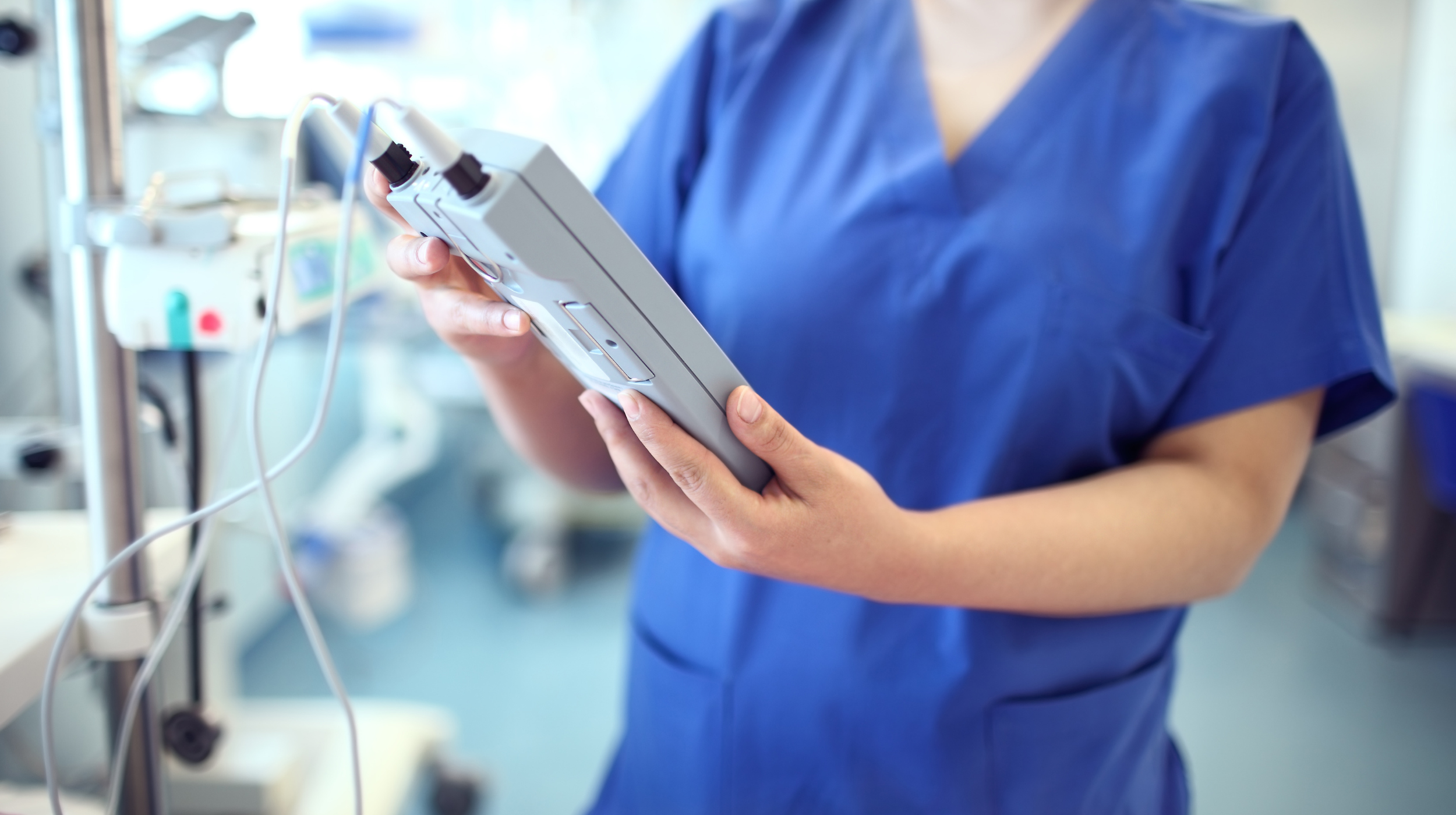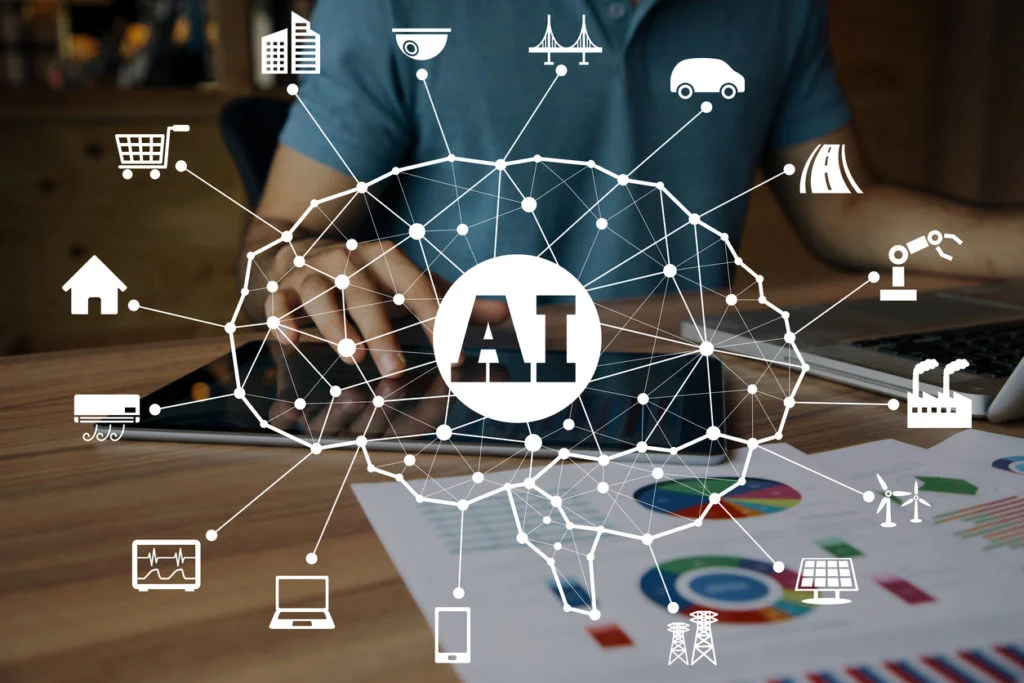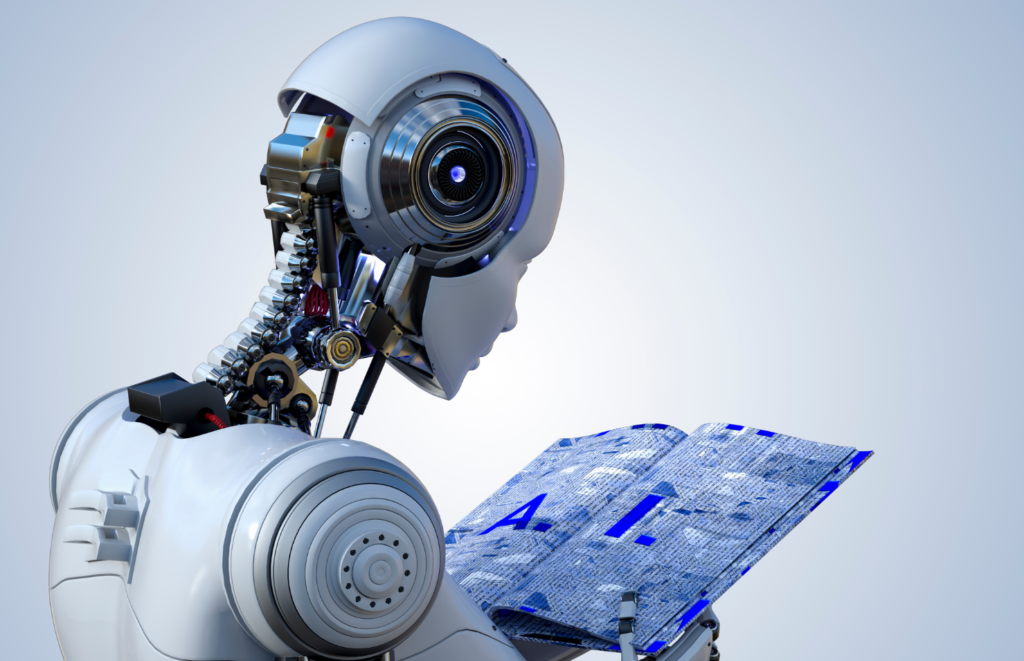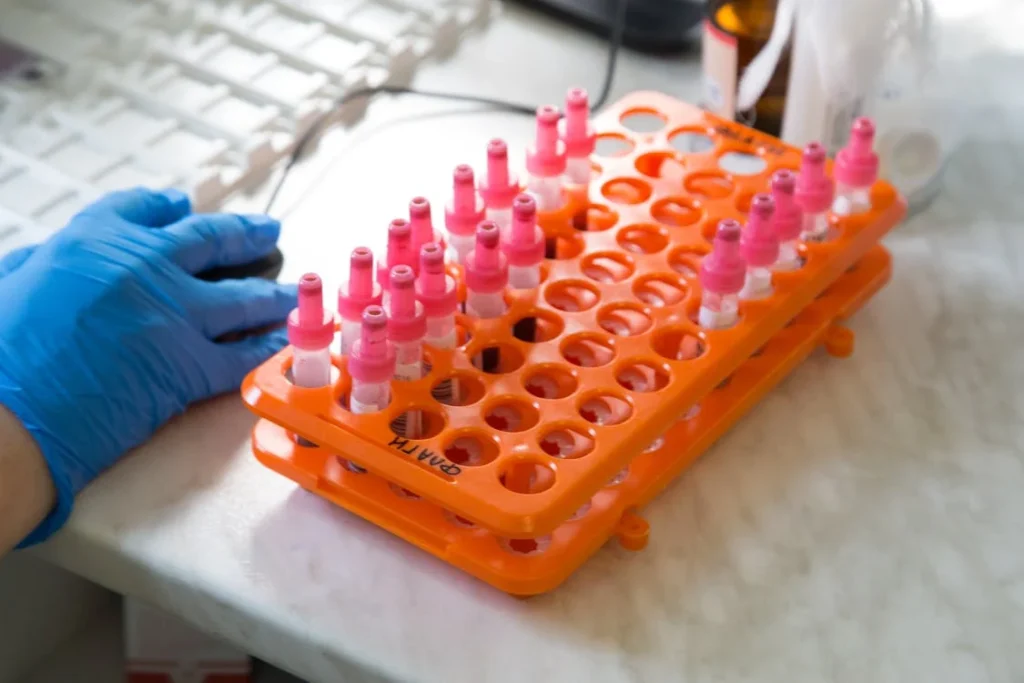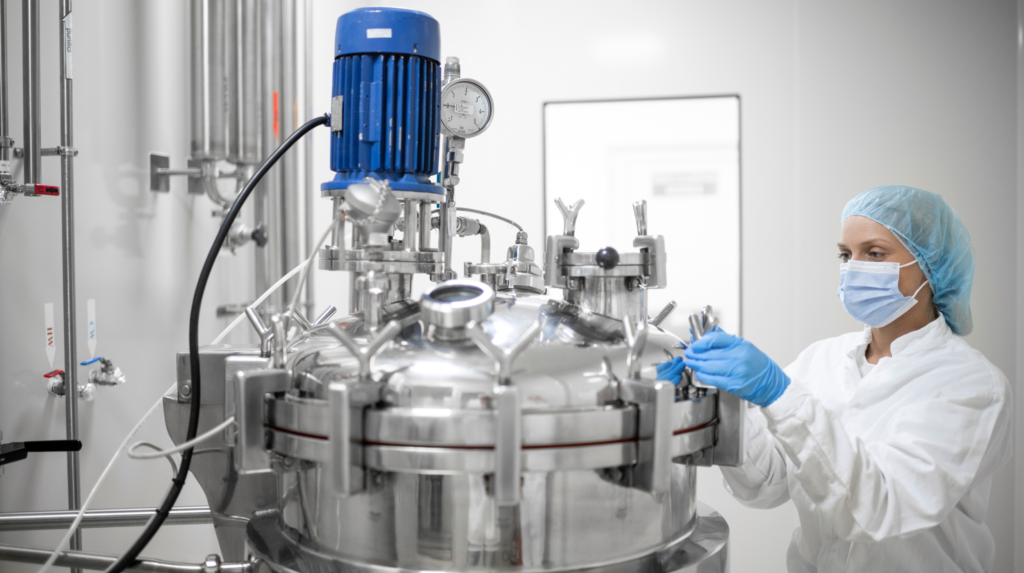Artificial intelligence (AI) is reshaping healthcare, offering innovative ways to improve diagnostics, treatment, and patient care. However, understanding how to use AI in medical devices effectively can be challenging, particularly for professionals seeking practical steps from concept to deployment.
There is a need for a structured approach to integrating AI into medical devices. Selecting the right AI techniques and ensuring compliance with healthcare regulations is crucial to making the most of this innovative technology to boost healthcare. AI in medical devices presents a new frontier for the healthcare industry.
The potential of AI in medical devices is immense, and the market is growing rapidly. According to a Grand View Research report, the global AI in healthcare market was valued at USD USD 22.4 billion in 2023 and is projected to reach USD 208.2 billion by 2030, with a CAGR of 37.5%. Software solutions lead the market, reflecting the increasing reliance on AI-powered analytics and decision-making.
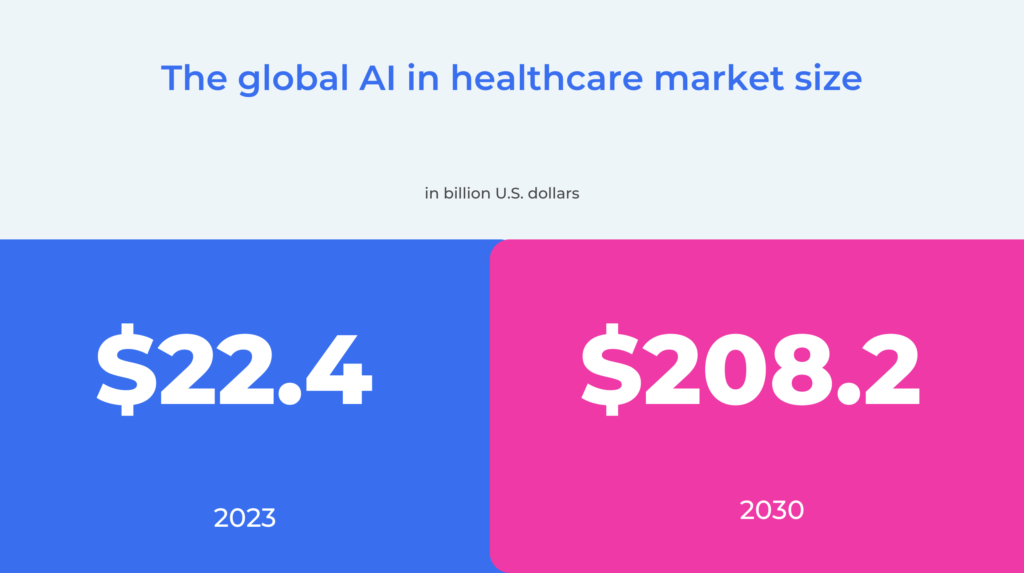
In North America, the largest revenue-generating region, healthcare organizations are leveraging AI in medical devices to improve precision and efficiency. This growing demand underscores the importance of adopting AI solutions that align with clinical needs and operational goals.
This guide will address the need for a structured approach to integrate AI into medical devices. From selecting the right AI techniques to ensuring compliance with healthcare regulations, we will look at actionable insights to successfully implement AI in medical devices.
The Categories of Medical Devices Benefiting from AI
Artificial intelligence is reshaping the capabilities of medical devices across a broad range of categories. Healthcare professionals can achieve improved accuracy, efficiency, and patient outcomes by integrating AI into diagnostics, monitoring, and therapeutic tools. This section explores the primary categories where AI significantly impacts, highlighting practical applications and real-world benefits.
Diagnostic Devices
Imaging Systems
AI is transforming medical imaging by analyzing scans such as X-rays, MRIs, CT scans, and ultrasounds with remarkable precision. These systems can detect abnormalities like tumors, fractures, or organ anomalies at earlier stages, assisting radiologists in delivering faster and more accurate diagnoses. The use of AI in medical devices ensures high consistency in image interpretation, reducing the margin for human error.
Point-of-Care Testing Devices
AI-powered point-of-care testing devices are revolutionizing diagnostics in decentralized healthcare settings. These tools analyze blood tests or biomarkers in minutes, providing rapid diagnostic results for conditions like infections, metabolic disorders, or cardiac issues. This use of AI in medical devices supports decision-making in emergency and outpatient scenarios, improving patient care.
Dermatology Devices
In dermatology, AI-driven devices analyze high-resolution images of the skin to detect conditions such as melanoma, eczema, or psoriasis. By evaluating subtle patterns and features invisible to the human eye, these systems assist dermatologists in identifying potentially life-threatening conditions early.
Monitoring Devices
Wearable Health Monitors
AI-enabled wearables such as smartwatches and fitness trackers continuously track vital signs, including heart rate, blood oxygen levels, and activity metrics, in real-time. These devices use AI in medical devices to detect irregularities like arrhythmias and flag potential health risks before they become critical.
AI-Powered Heart Monitoring Software for Medical Devices
Continuous Glucose Monitors (CGMs)
For diabetes management, AI-powered CGMs predict blood sugar trends and offer recommendations for insulin doses. These devices analyze patterns in glucose levels and alert users to potential highs or lows, making diabetes care more proactive and less burdensome.
Cardiac Monitoring Devices
AI-enhanced cardiac monitoring tools analyze ECG data to identify irregular heart rhythms or early signs of heart failure. These devices enable timely interventions and improve outcomes for patients with cardiovascular conditions, delivering promising results.
Therapeutic Devices
Implanted Devices
Pacemakers, insulin pumps, and neurostimulators are now integrating AI to optimize their performance in real-time. AI algorithms adjust device settings based on data such as heart rate or glucose levels, ensuring more effective and personalized treatments.
Robotic Surgery Systems
Robotic surgery systems equipped with AI enhance surgical precision and reduce manual errors. These systems provide surgeons with detailed visualizations, real-time guidance, and automated adjustments during procedures, improving outcomes for complex surgeries.
Rehabilitation Devices
Adaptive prosthetics and exoskeletons powered by AI adjust to the user’s movements, enhancing mobility and comfort. Rehabilitation devices also track metrics like range of motion and repetition counts, helping patients achieve their recovery goals efficiently.
Home Healthcare Devices
Smart Pill Dispensers:
AI-enabled smart pill dispensers help patients stick to medication schedules by providing reminders, tracking missed doses, and alerting caregivers if necessary. These devices enhance medication management, particularly for patients with chronic conditions.
Connected Devices
Blood pressure monitors and pulse oximeters use AI to analyze trends and flag anomalies. They seamlessly transmit data to cloud platforms or healthcare providers, enabling remote monitoring and early intervention when needed.
Sleep Apnea Devices
Sleep apnea devices with AI adjust airflow dynamically during sleep, ensuring uninterrupted breathing and better treatment compliance. These systems also provide insights into therapy effectiveness, allowing physicians to fine-tune patient care plans.
Other Categories
Early Detection and Prevention
AI supports the early detection of diseases, such as cancer, by analyzing biopsy results and non-invasive tests. These systems offer predictive insights based on genetic, lifestyle, or clinical data, enabling preventive care measures.
Emergency Devices
AI-integrated tools like automated external defibrillators (AEDs) guide untrained users with real-time instructions, improving survival rates in cardiac emergencies. Portable ultrasound devices with AI provide quick analysis and suggestions, especially in remote or emergency settings.
Assistive Tools
Devices like hearing aids and vision aids use AI to improve accessibility. They enhance speech recognition, filter noise, and assist visually impaired individuals by identifying objects or reading text aloud.
Categorizing AI Applications Based on Setup Needs
AI applications in medical devices require varying computational resources and connectivity levels, depending on the device’s purpose and operational environment. Categorizing these devices based on their computational needs and setup requirements helps healthcare professionals select the best approach for implementation.
Let’s discuss the four main categories: low computation power (Edge AI), moderate computation power (Hybrid AI), high computation power (Cloud-Dependent AI), and specialized AI configurations.
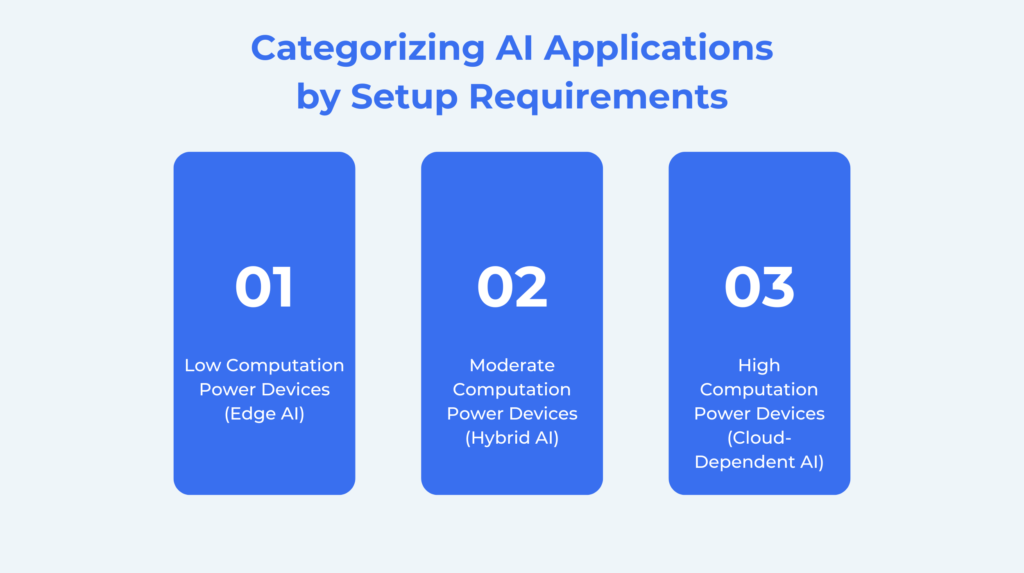
Low Computation Power Devices (Edge AI)
Low computation power devices use on-device AI processing, ensuring portability and efficiency. These devices are designed to perform specific tasks in real-time without relying on cloud connectivity, making them ideal for continuous monitoring and environments with limited internet access.
Characteristics
- Operates on minimal computational resources, typically using microcontrollers or compact processors.
- Designed for portability and energy efficiency, ensuring extended battery life.
- Provides real-time feedback without transferring sensitive data to the cloud, preserving user privacy.
Examples
- Wearables: Smartwatches and fitness trackers use on-device AI to monitor heart rate, activity levels, and sleep patterns. By processing data locally, they deliver insights instantly, making them valuable for daily health tracking.
- Rehabilitation Tools: AI-powered rehabilitation devices monitor patient movements during exercises and provide real-time feedback. These tools help optimize therapy sessions without the need for external data processing.
Relevance
AI in medical devices at the edge lets healthcare providers deliver accessible and cost-effective solutions for various applications. These devices suit patients requiring continuous monitoring in home or rural settings.
Moderate Computation Power Devices (Hybrid AI)
Moderate computation power devices combine edge processing with cloud integration, balancing real-time performance and advanced analytics. These devices are ideal for scenarios where some tasks can be handled locally while more complex analyses are offloaded to the cloud.
Characteristics
- Processes simpler tasks on-device while leveraging cloud resources for more computationally intensive tasks.
- Balances latency and advanced analytics, ensuring smooth operation even with intermittent connectivity.
- Reduces bandwidth usage by processing preliminary data locally.
Examples
- Connected Devices: Blood pressure monitors and glucose meters aggregate data locally and periodically transmit it to the cloud for trend analysis and anomaly detection. This approach enables immediate feedback while allowing for deeper insights over time.
- Portable Ultrasounds: AI-powered portable ultrasound devices guide users in capturing high-quality images locally and sending data to the cloud for advanced interpretations. This hybrid approach ensures usability even in areas with limited internet access.
Relevance
Hybrid AI devices demonstrate how to use AI in medical devices to bridge the gap between portability and computational sophistication. They are valuable for applications requiring both immediate results and comprehensive evaluations.
High Computation Power Devices (Cloud-Dependent AI)
High computation power devices rely heavily on cloud infrastructure to perform computationally intensive tasks such as deep learning model inference. These devices benefit from the virtually unlimited resources of cloud platforms but require stable internet connectivity to function effectively.
Characteristics
- Heavy reliance on cloud-based resources for advanced AI computations.
- Ideal for tasks requiring significant processing power and storage capacity, such as medical imaging and genomic analysis.
- Enables seamless updates and scalability as cloud systems evolve.
Examples
- Medical Imaging Systems: Devices analyzing X-rays, MRIs, and CT scans leverage cloud AI to precisely detect abnormalities such as tumors or fractures. This setup is vital for facilities handling large volumes of imaging data.
- Genomic Analysis Platforms: AI-powered genomic analysis tools process vast datasets to identify genetic markers for diseases. These systems require high-speed connectivity and advanced computational resources to deliver actionable insights.
Relevance
As a key driver of the AI in medical devices market, cloud-dependent solutions represent the pinnacle of technological capability. These systems enable healthcare providers to harness generative AI in medical devices for complex diagnostic and research applications.
Specialized AI Configurations (Custom AI Solutions)
Specialized AI configurations are tailored setups to meet unique device requirements or application-specific constraints. These solutions often focus on privacy, latency, or compliance with stringent regulatory standards.
Characteristics
- Includes federated learning, privacy-preserving AI, or AI deployed with hardware accelerators (e.g., GPUs, TPUs).
- Optimized for specific use cases such as real-time surgical guidance or decentralized data processing.
- Customizable to ensure compliance with regulations like HIPAA or GDPR.
Examples
- Robotic Surgery Systems: Equipped with dedicated AI hardware, these systems provide real-time precision guidance, enabling surgeons to perform intricate procedures with enhanced accuracy.
- Privacy-Focused Glucose Monitors: Devices employing federated learning analyze data locally, ensuring sensitive patient information remains secure.
Relevance
Generative AI in medical devices plays a significant role in developing custom configurations that address specific challenges. Understanding how to use AI in medical devices for tailored solutions is crucial for applications requiring high accuracy, privacy, or localization.
By categorizing AI applications based on their computational needs and configurations, healthcare professionals can align their device development strategies with specific operational requirements.
AI Techniques and Their Applications in Healthcare
Artificial intelligence in medical devices encompasses a variety of techniques, each offering distinct capabilities for improving healthcare outcomes. From predictive diagnostics to privacy-preserving data analysis, these techniques drive innovation in the healthcare industry. Let’s discuss some key AI techniques, their use cases, and their role in advancing medical device functionality.
Machine Learning (ML)
Machine Learning (ML) is the foundation for many AI applications in medical devices. It involves training algorithms on large datasets to identify patterns and make predictions, empowering healthcare providers with actionable insights.
Use Cases
- Predictive Diagnostics: ML models analyze patient data to predict disease risks and early symptoms. For example, an AI-enabled wearable device might alert users to potential arrhythmias based on their heart rate patterns.
- Trend Analysis: By monitoring health data over time, ML algorithms detect deviations from normal trends, enabling early interventions. These applications are vital for managing chronic conditions like diabetes or hypertension.
ML’s versatility ensures its integration into a wide range of medical devices, showcasing how to use AI in medical devices effectively. This technology enhances diagnostic accuracy and supports personalized care plans, making it an essential tool in modern healthcare.
Deep Learning (DL)
Deep Learning (DL), a subset of ML, uses neural networks to process complex data such as images, videos, and signals. It excels in applications requiring high precision and the ability to analyze unstructured data.
Use Cases
- Imaging Analysis: DL algorithms power medical imaging systems by identifying anomalies in X-rays, CT scans, and MRIs. These systems can detect conditions such as tumors, fractures, or organ anomalies with remarkable accuracy, aiding radiologists in their assessments.
- Signal Processing: Devices like ECG monitors rely on DL to interpret waveform data and identify abnormalities, such as irregular heart rhythms or early signs of heart failure.
Generative AI in medical devices often leverages DL to create synthetic data for training models or simulate medical scenarios. As a cornerstone of AI in medical devices, DL plays a crucial role in advancing diagnostic and therapeutic capabilities, significantly contributing to the growing AI in the medical devices market.
NLP and Reinforcement Learning (RL)
Natural Language Processing (NLP) and Reinforcement Learning (RL) address distinct areas of medical device applications, from data interpretation to robotic precision.
Use Cases
- NLP for Insights: NLP enables medical devices to interpret unstructured textual data, such as electronic health records (EHRs) or clinical notes. This capability supports clinical decision-making by extracting meaningful information from large volumes of text. Telemedicine platforms also use NLP to analyze patient symptoms and recommend treatment options.
- RL for Robotics: Reinforcement Learning enhances robotic surgical systems by enabling them to adapt to complex and dynamic surgical environments. For example, RL algorithms can train robotic arms to perform precise movements during minimally invasive procedures, reducing errors and improving patient outcomes.
These techniques demonstrate how to use AI in medical devices to address both cognitive and physical challenges in healthcare. By combining data interpretation with real-time learning, NLP and RL broaden the scope of AI applications in medical devices.
Federated Learning and Expert Systems
Federated Learning and Expert Systems cater to specific needs like privacy preservation and rule-based decision-making.
Use Cases
- Federated Learning: This technique enables decentralized training of AI models across multiple devices without transferring sensitive data to a central location. It is particularly useful for applications like wearable health monitors, where privacy and compliance with regulations like HIPAA are critical.
- Expert Systems: These rule-based systems provide straightforward decision-making capabilities. For example, an AI-enabled pharmacovigilance platform might alert healthcare providers to potential drug interactions based on predefined rules.
Federated Learning and Expert Systems highlight the potential of generative AI in medical devices to address privacy concerns while ensuring accurate diagnostics. These technologies underscore the importance of tailoring AI approaches to specific healthcare challenges.
Hybrid AI and Computer Vision
Hybrid AI and Computer Vision combine the strengths of multiple AI techniques to deliver advanced analytics and image-based diagnostics.
Use Cases
- Hybrid AI for Multi-Modal Analytics: Hybrid AI integrates data from various sources, such as imaging, lab results, and patient histories, to provide a comprehensive view of a patient’s condition. This multi-modal approach improves diagnostic accuracy and facilitates personalized treatment plans.
- Computer Vision for Diagnostics: Computer vision enables devices to process and analyze visual data, such as skin lesions or retinal scans. AI-powered dermatology tools, for instance, identify patterns that indicate conditions like melanoma or psoriasis.
The use of AI in medical devices, particularly hybrid AI and computer vision, showcases how to integrate diverse data streams into a cohesive diagnostic framework. These technologies highlight AI’s potential to revolutionize diagnostic precision and patient care.
AI techniques like ML, DL, NLP, RL, Federated Learning, and Hybrid AI have transformed how medical devices function, enabling enhanced diagnostics, data security, and multi-faceted analytics. Healthcare professionals can continue to innovate and improve patient outcomes by leveraging these tools.
Step-by-Step Guide to Implementing AI in Medical Devices
Implementing AI in medical devices is a complex but rewarding process that requires careful planning and execution. By following a structured approach, healthcare organizations can maximize the potential of AI while addressing regulatory, technical, and ethical challenges.
Here’s a quick outline for a nine-step guide to help healthcare professionals and device manufacturers go through the process of creating or upgrading AI-powered medical devices.
Step 1 – Define Business Goals and Pre-Requisites
The first step in implementing AI in medical devices is to define clear business goals. Organizations must determine whether their goals are market-driven or technology-driven.
- Market-Driven Goals: These focus on addressing specific healthcare needs, such as improving diagnostic accuracy or reducing patient wait times. For example, AI-powered imaging systems that detect early-stage cancers can meet unmet market demand.
- Technology-Driven Goals: These leverage emerging AI capabilities to introduce groundbreaking solutions. For instance, generative AI in medical devices might create new opportunities for personalized rehabilitation devices.
Organizations must also identify key prerequisites, like regulatory compliance (e.g., FDA or GDPR), budget constraints, and target audience needs. Understanding how to use AI in medical devices begins with aligning goals and requirements to ensure a clear roadmap for development.
Step 2 – Identify Device Category
Once goals are defined, the next step is to identify the medical device category and align it with AI capabilities. AI integration strategies can differ significantly across device types, so understanding the device’s functionality is critical.
Device Categories
- Diagnostic Devices: Examples include imaging systems and point-of-care diagnostic tools that rely on AI for rapid and accurate results.
- Monitoring Devices: Wearables and continuous glucose monitors use AI to track real-time health metrics.
- Therapeutic Devices: Robotic surgery systems and rehabilitation tools integrate AI for precision and adaptability.
Understanding the specific category helps tailor AI implementation to meet clinical needs effectively. This alignment ensures the use of AI in medical devices enhances functionality while addressing operational requirements.
Step 3 – Assess Computation Power Needs
Determining the computational power requirements is a crucial step in the process. AI configurations must match the device’s operational needs, ensuring a seamless balance between functionality and performance.
Key Considerations
- Low Computation Power (Edge AI): Ideal for wearables and other portable devices that operate in offline or low-bandwidth environments.
- Moderate Computation Power (Hybrid AI): Suited for devices requiring a combination of on-device and cloud processing, such as connected diagnostic tools.
- High Computation Power (Cloud-Dependent AI): Required for devices handling complex tasks, such as medical imaging systems or genomic analysis platforms.
Matching computational needs to the device ensures optimal performance while leveraging generative AI in medical devices for advanced applications.
Step 4 – Choose AI Techniques
Selecting the right AI techniques is vital for achieving the outcomes you want. Different techniques are suited to different functionalities, so organizations must carefully evaluate their options.
Key Techniques
- Machine Learning (ML): Ideal for predictive diagnostics and trend analysis.
- Deep Learning (DL): Best for image analysis and signal processing in devices like MRIs and ECG monitors.
- Natural Language Processing (NLP): Useful for telemedicine platforms and clinical decision support.
The choice of technique depends on the type of data being processed and the specific goals of the device. Effectively using AI in medical devices requires selecting tools that align with these objectives.
Step 5 – Evaluate Existing vs. New Product Opportunities
Organizations must decide whether to upgrade an existing device or create a new one.
- Upgrading Existing Devices: Adding AI capabilities to existing devices can extend their lifecycle and provide faster time-to-market. For example, integrating AI into an existing glucose monitor can enhance its predictive capabilities.
- Creating New Devices: Developing AI-first devices allows for greater innovation but requires significant investment in R&D and market education.
Evaluating these opportunities ensures alignment with the AI in the medical devices market and helps organizations focus their resources effectively.
Step 6 – Plan Development and Deployment
A well-defined plan for development and deployment is a cornerstone of successfully integrating AI into medical devices. This phase transforms innovative concepts into functional, reliable, and market-ready solutions.
Steps to Follow
- Data Collection: High-quality data is the foundation of any AI-driven device. Collect data from diverse sources, such as clinical trials, public datasets, and partnerships with healthcare providers. Diversity in data ensures the AI model performs robustly across different patient demographics and scenarios, minimizing bias and improving generalizability.
- Model Training and Validation: Use frameworks like TensorFlow or PyTorch to train AI models. This involves feeding the collected data into algorithms to learn patterns and make predictions. Validation is equally critical—it ensures the model achieves the desired accuracy, sensitivity, and specificity levels. Iterative testing is key to refining the model for real-world conditions.
- Prototyping: Develop a Minimum Viable Product (MVP) that incorporates essential AI features. Testing the MVP in controlled environments allows for fine-tuning the device’s functionality and identifying potential issues before full-scale deployment. Prototypes provide valuable insights into the device’s usability and effectiveness.
This step is vital for leveraging generative AI in medical devices. A strategic approach ensures the final product is reliable, compliant, and ready to meet healthcare needs effectively.
Step 7 – Address Ethical, Regulatory, and Security Aspects
Ethical and regulatory considerations must be integrated into the development process to ensure compliance with healthcare standards.
Key Areas
- Regulatory Compliance: Meet the requirements of agencies like the FDA or CE for safety and efficacy.
- Ethical Concerns: Address issues like data bias and accountability for AI-driven decisions.
- Data Security: Implement robust encryption and regular updates to protect patient data from cyber threats.
Sticking to these standards is essential for gaining trust in the AI in medical devices market.
Step 8 – Market Testing and Iteration
Testing the device in real-world scenarios allows organizations to refine their AI models and improve usability.
Key Actions
- Conduct trials with healthcare providers and patients to gather feedback.
- Refine AI algorithms based on performance and user input.
- Iteratively improve device features to enhance its clinical impact.
Understanding how to use AI in medical devices effectively involves continuous refinement to meet user expectations and clinical needs.
Step 9 – Scale and Commercialize
The final step involves scaling the AI solution and introducing it to the market.
Key Considerations
- Scalability: Optimize AI models to handle larger datasets and broader user bases.
- Commercialization Strategy: Develop partnerships with healthcare providers, insurers, or research institutions to drive adoption.
- Recurring Revenue Models: Explore subscription-based services or software updates to ensure long-term profitability.
Generative AI in medical devices is crucial for creating scalable and innovative solutions and positioning organizations for success in the competitive market.
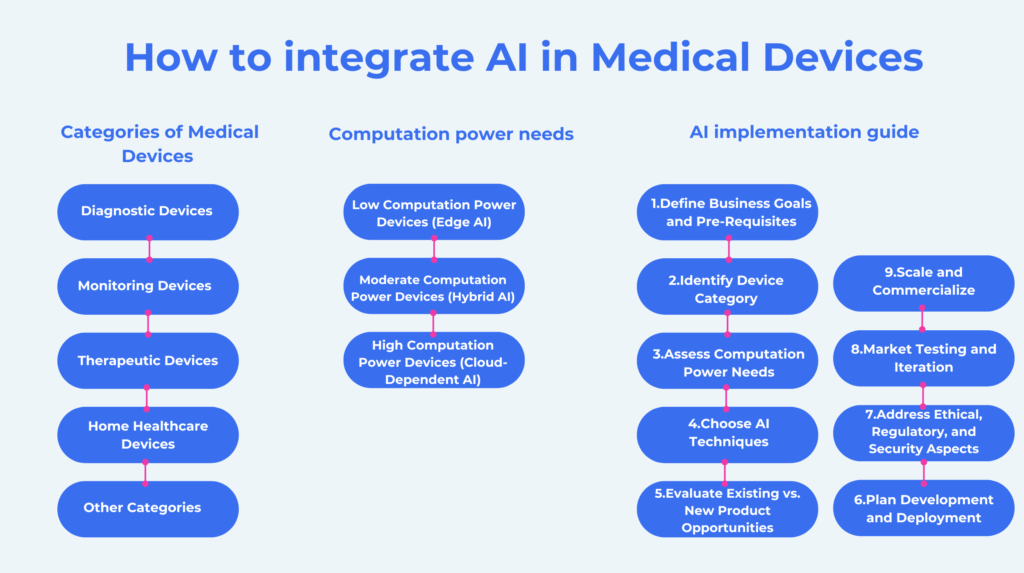
Business Considerations Before Implementing AI in Medical Devices
Implementing AI in medical devices requires careful consideration of market needs, regulatory frameworks, cost implications, and long-term scalability. Addressing these factors upfront can help you use AI-driven solutions while minimizing risks.
Before we discuss the critical business considerations that healthcare organizations and device manufacturers must consider before deploying AI-enabled devices, let’s take a quick look at core AI techniques and their specific applications:
| AI Technique | Key Use Cases | Example Applications |
| Machine Learning (ML) | Predictive diagnostics, trend analysis, risk stratification | POCT devices, wearable health monitors, blood test analyzers |
| Deep Learning (DL) | Medical imaging analysis, signal processing, pathology and histology | MRI/CT scanners, ECG devices, digital pathology platforms |
| Natural Language Processing (NLP) | Clinical decision support, telemedicine insights, medical transcription | Telemedicine platforms, electronic health records (EHR) systems |
| Computer Vision (CV) | Skin condition detection, movement tracking, emergency diagnostics | Dermatology tools, rehabilitation assistants, portable diagnostic cameras |
| Reinforcement Learning (RL) | Robotic surgery optimization, adaptive rehabilitation exercises | Surgical robots, AI-guided rehabilitation tools |
| Federated Learning | Privacy-preserving AI, decentralized wearable data analysis | Distributed diagnostic devices |
| Expert Systems | Rule-based diagnostics, drug interaction alerts | Decision support systems, pharmacovigilance platforms |
| Hybrid AI | Multi-modal diagnostics, integrated healthcare solutions | Lab diagnostics integrating imaging and text, telehealth platforms with diverse analytics |
Now, let’s explore key business considerations you must address before implementing AI-powered healthcare devices:
Market vs. Technology Approach
Balancing market demand with technological innovation is crucial when introducing AI in medical devices.
- Market-Driven Approach: This strategy focuses on solving well-defined problems with clear demand. For instance, diagnostic tools that reduce patient waiting times or monitoring devices tailored for chronic disease management are aligned with specific market needs. This approach ensures immediate relevance and adoption by addressing gaps in care delivery.
- Technology-Driven Approach: In contrast, this strategy leverages emerging AI capabilities to create new opportunities. For example, generative AI in medical devices may unlock previously unimaginable applications, like personalized rehabilitation devices. However, this path often requires significant investment in market education and may take longer to gain traction.
Striking the right balance between these approaches ensures that AI devices meet real-world clinical needs while capitalizing on cutting-edge advancements.
Cost-Benefit Analysis
Understanding the costs and benefits of AI integration is essential for ensuring a sustainable return on investment (ROI).
Cost Considerations
- Development and Deployment: Building AI models, training algorithms, and integrating them into devices requires significant initial investment.
- Compliance and Certification: Meeting regulatory standards, such as FDA or GDPR compliance, adds to the upfront costs.
- Infrastructure: Cloud-dependent devices or those requiring specialized hardware like GPUs may incur ongoing operational expenses.
Benefits
- Improved Efficiency: AI streamlines diagnostics, reduces manual intervention, and enhances device functionality.
- Enhanced Outcomes: Devices that leverage AI often improve patient outcomes, which can translate to higher market adoption.
- Recurring Revenue Models: Subscription-based AI features or cloud services offer long-term revenue potential.
By weighing these costs and benefits, businesses can prioritize AI features that deliver the most significant impact while maintaining financial viability.
Ethical, Regulatory, and Security Concerns
AI in medical devices operates in a highly regulated environment, making ethical and legal considerations paramount.
Ethical Concerns
- Bias: AI models trained on non-representative datasets may lead to biased outcomes. Ensuring diversity in training data is critical for fairness.
- Accountability: Defining responsibility for AI-driven decisions is vital, particularly in high-risk applications like surgery or diagnostics.
Regulatory Compliance
- Data Privacy: Regulations like HIPAA in the US or GDPR in Europe mandate robust data security protocols.
- Certification: Gaining regulatory approval for AI-driven devices involves demonstrating safety, efficacy, and reliability under real-world conditions.
Security
- Cybersecurity Risks: Connected medical devices are vulnerable to breaches. Implementing encryption, regular updates, and security audits minimizes these risks.
By addressing these concerns proactively, organizations can build trust with regulators, clinicians, and patients.
Scalability and Longevity
Designing AI solutions that can scale with demand and remain relevant over time is a crucial factor to consider.
- Scalability: Cloud-based AI systems provide flexibility to handle increasing volumes of data and user demands. Devices designed with modular architectures can also accommodate future upgrades.
- Longevity: Future-proofing devices involves ensuring compatibility with emerging technologies, such as federated learning or advanced data privacy methods. Regular software updates and AI model retraining are necessary to maintain relevance and accuracy.
Organizations must plan for the long-term viability of their AI solutions to stay competitive in the fast-evolving healthcare market.
Empower Your Healthcare Devices with AI-Driven Innovation Through Achievion
Integrating AI into medical devices unlocks unparalleled opportunities to enhance diagnostics, monitoring, and patient care while optimizing healthcare operations. With Achievion, you can harness the power of AI to revolutionize medical devices, improve patient outcomes, and drive innovation in healthcare.
We specialize in building intelligent, efficient, and compliant AI-powered solutions, backed by our extensive experience in the medical device industry. From navigating complex regulatory landscapes to developing cutting-edge technologies, our expertise ensures your devices meet the highest standards of precision, reliability, and care.
Contact Achievion today to leverage our expertise and bring your innovative medical device vision to life.



